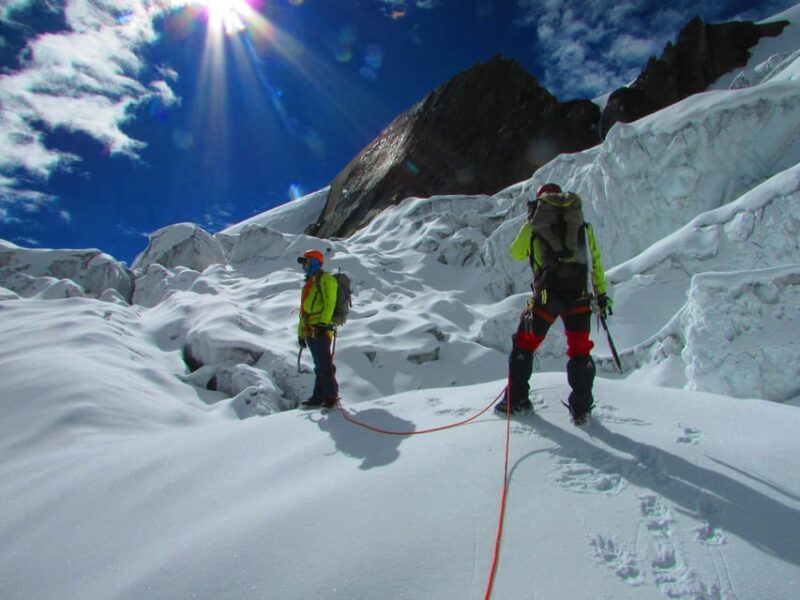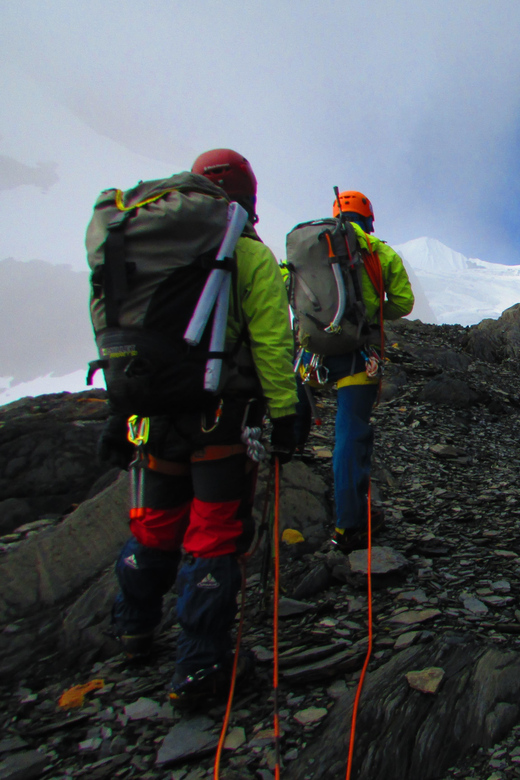Venturing from the quaint town of Lukla, adventurers embark on a remarkable 16-day journey to conquer the majestic Lobuche East Peak, standing tall at 6,119 meters. This captivating expedition immerses trekkers in the breathtaking landscapes of the Khumbu region, showcasing vibrant Sherpa villages and unparalleled vistas of iconic peaks. However, the ascent along the south-east ridge presents a true test of skill, featuring challenging 45-degree slopes that demand technical expertise and proper acclimatization. As climbers reach the summit, they’re rewarded with panoramic views that forever etch unforgettable memories. But what lies beyond the summit, and how can one prepare for this thrilling adventure?
Key Points

- The trekking route from Lukla (2,800m) to Lobuche East Peak (6,119m) takes approximately 16 days and includes acclimatization hikes.
- The technical climbing route follows the south-east ridge, involving mixed climbing with 45-degree snow slopes and fixed ropes.
- Summiting Lobuche East Peak offers panoramic views of iconic Himalayan peaks such as Everest, Lhotse, and Nuptse.
- The expedition requires both technical mountaineering skills and strong physical endurance to overcome the challenges of the terrain.
- The trekking experience also includes culture in the Sherpa communities and appreciation for the natural beauty of the Khumbu region.
Overview of the Activity

The Lobuche East Peak Climbing adventure is a challenging high-altitude expedition that takes trekkers from the lively town of Lukla (2,800m) to the summit of Lobuche East Peak at 6,119m.
Over the course of 16 days, climbers will trek through the Khumbu region, acclimatizing along the way before attempting the technical summit. The itinerary includes highlights like reaching the Everest Base Camp, hiking to Kala Patthar for stunning Himalayan vistas, and navigating the Lobuche Base Camp.
Climbers will encounter a mix of rock, snow, and ice on the 45-degree slopes, requiring the use of fixed ropes on many sections. The reward at the top? Breathtaking panoramic views of Everest, Lhotse, Nuptse, and other giants of the Himalayan range.
You can also read our reviews of more tours and experiences in Koshi Zone.
Itinerary Highlights

The Lobuche East Peak Climbing expedition kicks off in Lukla (2,800m), where climbers embark on a 45-minute trek to Phakding (2,610m).
They then ascend to Namche Bazaar (3,446m) in 4-5 hours. After acclimatizing in Namche, the group continues to Tengboche (3,860m) and Dingbouche (4,240m).
Acclimatization hikes to Nagarjun Hill (5,000m) prepare them for the climb. From Dingbouche, they trek to Lobuche, Gorakshep, and Everest Base Camp before summiting Lobuche East Peak (6,119m).
The descent takes them through Pheriche and Namche back to Lukla, completing the 16-day journey.
Climbing Details

Lobuche East Peak, standing at a formidable 6,119 meters, was first summited on April 25, 1984, by Laurence Nielson and Sherpa Ang Gyalzen.
The normal route follows the south-east ridge, offering a mix of rock, snow, and ice climbing. Climbers can expect 45-degree snow slopes, with fixed ropes on most sections.
The summit offers breathtaking views of Everest, Lhotse, Nuptse, Ama Dablam, and Pumori.
Key climbing features include:
- Challenging snow and ice slopes requiring technical skills.
- Thin air and high altitude, demanding proper acclimatization.
- Potential weather changes, requiring flexibility and adaptability.
First Ascent and Route
When was Lobuche East Peak first summited, and what is the normal climbing route? Lobuche East Peak was first scaled on April 25, 1984, by Laurence Nielson and Sherpa Ang Gyalzen. The standard route up the mountain is the South-East ridge, which involves a mix of rock, snow, and ice climbing. Climbers can expect to encounter 45-degree snow slopes and fixed ropes on most sections of the route.
| Climbing Features | Details |
|---|---|
| Slope Angle | 45 degrees |
| Terrain | Rock, snow, ice |
| Climbing Aids | Fixed ropes |
The panoramic views from the summit include the iconic peaks of Everest, Lhotse, Nuptse, Ama Dablam, and Pumori.
More Great Thing To Do NearbyClimbing Features and Views
Mountaineers tackling Lobuche East Peak can anticipate encountering 45-degree snow slopes along the South-East ridge route. Fixed ropes are set up on most sections to assist climbers.
The panoramic views from the 6,119m summit are nothing short of breathtaking, encompassing the majestic Everest, Lhotse, Nuptse, Ama Dablam, and Pumori.
This technical climb offers a thrilling mix of rock, snow, and ice elements, testing the skills and endurance of even the most experienced mountaineers. The challenge is well worth the effort, as climbers are rewarded with:
- Awe-inspiring vistas of the mighty Himalayan giants.
- A profound sense of accomplishment in summiting a technically demanding peak.
- Cherished memories of their Lobuche East Peak climbing adventure.
Cultural and Scenic Experiences
Beyond the technical climbing challenges, the Lobuche East Peak adventure offers a rich cultural and scenic immersion.
Trekkers will discover the Sherpa way of life, with its traditions, Mani walls, and prayer flags fluttering in the wind. Along the way, they’ll encounter the sturdy, sure-footed yaks, the backbone of the region’s transportation.
The trek also showcases the stunning natural beauty of the Khumbu region, from the turquoise lakes of Gokyo to the breathtaking vistas of Everest, Lhotse, Nuptse, and Ama Dablam.
This multifaceted experience provides a deeper appreciation of the Himalayas and the resilient people who call this extraordinary landscape home.
Inclusions in the Package
The Lobuche East Peak climbing package includes an array of essential services and support for trekkers.
Airport transfers, ground transportation, and tea house accommodations are provided throughout the journey. Meals during the trek, including breakfast, lunch, dinner, and tea/coffee, are also included.
Plus, the package covers national park and trekking permits, peak climbing permit, an experienced trekking and climbing guide, a comprehensive first aid kit, and a flight ticket for the guide.
These inclusions ensure a seamless and well-supported experience for adventurers tackling the Lobuche East Peak expedition.
The package includes the following key elements:
- Ground transfers, tea house accommodations, and all meals during the trek.
- Necessary permits and an experienced guide to ensure a safe and successful climb.
- First aid support and other logistics to enhance the overall experience.
Exclusions From the Package
While the Lobuche East Peak climbing package covers a comprehensive set of services, there are certain exclusions that trekkers should be aware of.
The package doesn’t include international airfare or hotel accommodations in Kathmandu. Trekkers must also cover their personal expenses, such as snacks, bottled water, and souvenirs.
Travel insurance is another important expense that’s not covered, which is essential for medical emergencies and trip cancellations.
Plus, the package excludes tips for the trekking and climbing guides, which are customary in this region.
Frequently Asked Questions

What Are the Physical and Technical Requirements for This Climb?
The climb requires excellent physical fitness, previous mountaineering experience, and technical skills in rock, snow, and ice climbing. Climbers need to be comfortable with steep 45-degree slopes, fixed ropes, and managing the high altitude conditions.
How to Prepare for the High-Altitude Conditions During the Trek?
To prepare for high-altitude conditions, climbers should gradually acclimatize by hiking to progressively higher elevations, stay hydrated, eat nutritious foods, and monitor their breathing and heart rate. Proper pacing and rest are crucial for a successful and safe climb.
What Is the Best Time of Year to Attempt the Lobuche East Peak?
The best time to attempt Lobuche East Peak is typically in the spring (April-May) or fall (October-November) when the weather is mild, skies are clear, and temperatures are moderate – ideal for high-altitude mountaineering.
Can Solo Trekkers Join This Expedition, or Is It Group-Based?
This expedition is group-based, though solo trekkers can join. Group sizes typically range from 2 to 12 participants. Solo trekkers should have extensive high-altitude trekking experience and be comfortable joining a guided group.
What Is the Success Rate for Summiting Lobuche East Peak?
The success rate for summiting Lobuche East Peak varies, typically ranging from 60-80%. Factors like weather, fitness, and experience of the team impact the summit rate. Proper planning, acclimatization, and a skilled guide are key to improving the chances of reaching the top.
Recap
The expedition to Lobuche East Peak is a captivating challenge that blends technical climbing with breathtaking Himalayan scenery. Trekkers will enjoy Sherpa culture, witness the grandeur of Everest, and achieve the rewarding summit. With careful preparation and guidance, adventurers can conquer this impressive peak and create unforgettable memories in the heart of the Khumbu region.
You can check if your dates are available here:More Tour Reviews in Koshi Zone
Not for you? Here's more things to do in Koshi Zone we have recnetly reviewed
- 4 Best Tours In Koshi Zone
- 4 Best Helicopter Flights And Tours In Koshi Zone
- 4 Best Hiking And Trekking Tours In Koshi Zone
- Private Luxury Everest View 5 Days Heli Tour
- Everest Base Camp Overnight Stay Trek – 15 Days
- Kathmandu Everest Helicopter Tour With Guranteed Landing
- From Lukla: Mera Peak (6,476m) Climbing
- Island Peak (6,189m) Climbing
